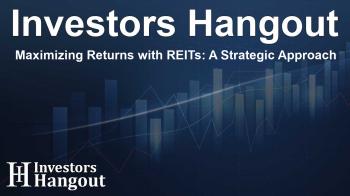Maximizing Returns with REITs: A Strategic Approach

Understanding the Impact of Treasury Rates on Investments
The economic landscape is always shifting, and as of late, it’s crucial to focus on the implications of the yield on the 10-year Treasury note. This indicator plays a pivotal role in guiding investment decisions for those interested in generating income, particularly through dividends.
Why is the 10-year Treasury yield so important? Its movements can greatly influence various sectors, especially real estate investment trusts (REITs). When the administration changes, as it is now, all eyes should be on how this yield is set to fluctuate.
The Art of Timing: Engaging with Treasury Rates
Investors are often advised not to “fight the Fed,” but a more fitting mantra for today’s economy could be “Don’t disregard the 10-year Treasury yield!” This yields insight for investors keen on anticipating market shifts. By understanding when to maneuver in and out of equities and fixed income, judicious investors can reap both capital gains and attractive dividend distributions.
For example, since recent rate-cutting began, the yield on the 10-year Treasury has surged from 3.7% to approximately 4.6%. This shift indicates that as the Fed decreases rates, the bond market is still reacting strongly, suggesting an adjustment is necessary.
Investing Wisely in REITs Under Current Conditions
Given the current climate, now is an excellent time to reconsider your investments in REITs. These entities, often referred to as the “landlords” of the investment world, are primed for growth as the yield on the 10-year Treasury stabilizes. Currently, buying REITs can be a strategic move because their values often increase as bond rates start to decrease after a peak.
The main appeal lies in their dividends. REITs are permitted tax-relief as long as they distribute at least 90% of their earnings as dividends. This structure allows them to operate as pass-through entities, offering a lucrative option for income-seeking investors.
Making Profitable Decisions with REITs
Once you’ve built a strong foundational understanding of how to assess these investments, consider their trajectory based on current market dynamics. Investors often hold onto these stocks for long periods due to their robust payouts. But with the 10-year yield seemingly reaching a peak, it's essential to adopt a strategy that allows for quick profit-taking.
For instance, in our recent investment strategy, we focused on Ventas (NYSE: VTR), a REIT with a diverse portfolio concentrated in healthcare real estate. Despite facing a decline earlier in the year, the prevailing circumstances positioned it well for a bounce-back as the market corrected itself.
The Benefits of Swing Trading REITs
Engaging in swing trades with REITs gives investors the chance to capitalize on the volatile nature of interest rates. In fact, during our last transaction, we capitalized on a peak in yields, acquiring Ventas when it was undervalued and securing an impressive 11.1% return in just a few weeks.
This gain outperformed many traditional investment sectors and showcased the benefits of strategic trading in response to market signals.
Conclusion: Seizing the Moment with REIT Investments
With the unavoidable fluctuations in the 10-year Treasury yield, the savvy investor knows it’s essential to adapt strategies accordingly. As the yield stabilizes and possibly descends, now is an opportune time to consider REITs for their dividends and potential for price appreciation. With cautious timing and a proactive approach, you can successfully navigate these investment waters.
Frequently Asked Questions
What is the 10-year Treasury yield and why is it important?
The 10-year Treasury yield reflects the return on debt obligations issued by the U.S. government. It serves as a benchmark for various loans and can influence a range of investment decisions.
Why should I consider investing in REITs?
REITs offer the potential for stable dividends and can provide a hedge against inflation, making them an attractive investment for income-focused portfolios.
How does the yield on the 10-year Treasury affect REITs?
Typically, REIT values inversely correlate with the 10-year Treasury yield. As yields increase, REIT stock prices may decrease, and vice versa.
What is swing trading and how can it benefit me?
Swing trading involves taking advantage of short-term price movements in stocks. Investors can profit by timely buying and selling assets in accordance with market trends.
What types of REITs should I consider?
Investors may explore various sectors within REITs such as healthcare, residential, and commercial properties, depending on their financial goals and market outlook.
About The Author
Contact Olivia Taylor privately here. Or send an email with ATTN: Olivia Taylor as the subject to contact@investorshangout.com.
About Investors Hangout
Investors Hangout is a leading online stock forum for financial discussion and learning, offering a wide range of free tools and resources. It draws in traders of all levels, who exchange market knowledge, investigate trading tactics, and keep an eye on industry developments in real time. Featuring financial articles, stock message boards, quotes, charts, company profiles, and live news updates. Through cooperative learning and a wealth of informational resources, it helps users from novices creating their first portfolios to experts honing their techniques. Join Investors Hangout today: https://investorshangout.com/
The content of this article is based on factual, publicly available information and does not represent legal, financial, or investment advice. Investors Hangout does not offer financial advice, and the author is not a licensed financial advisor. Consult a qualified advisor before making any financial or investment decisions based on this article. This article should not be considered advice to purchase, sell, or hold any securities or other investments. If any of the material provided here is inaccurate, please contact us for corrections.

